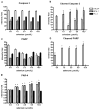Differential effects of selenium on benign and malignant prostate epithelial cells: stimulation of LNCaP cell growth by noncytotoxic, low selenite concentrations
- PMID: 19235042
- PMCID: PMC2821820
- DOI: 10.1080/01635580802398430
Differential effects of selenium on benign and malignant prostate epithelial cells: stimulation of LNCaP cell growth by noncytotoxic, low selenite concentrations
Abstract
We examined the hypothesis that nontoxic concentrations of selenium induce apoptosis and growth inhibition selectively in prostate cancer cells but not in benign prostate cells. Nontumorigenic BPH-1 prostate epithelial cells, androgen-sensitive LNCaP, and androgen-independent PC-3 prostate cancer cells were exposed to sodium selenite at 1 to 10 micromol/l for 24 to 72 h. Cell proliferation, viability, and apoptosis were assessed by MTT assay, trypan blue exclusion, flow cytometry, DNA laddering, and caspase activation. BPH-1 cells were more sensitive for cytotoxic selenium effects than malignant prostate cells, whereas LNCaP cells were more sensitive than PC-3 cells. At noncytotoxic selenium concentrations, there was no apoptosis in BPH-1 and PC-3 cells and no growth inhibition of LNCaP and BPH-1 cells. PC-3 cells were refractory to apoptosis induction but were growth inhibited at noncytotoxic concentrations. LNCaP cells were growth stimulated at 1 micromol/l and sensitive to apoptosis induction at higher noncytotoxic concentrations. Thus, noncytotoxic selenite concentrations did not induce growth inhibition or apoptosis selectively in prostate cancer cells. Growth stimulation of LNCaP cells by low concentrations suggests the possibility of adverse effects of selenium supplementation on hormone sensitive prostate cancer, whereas inhibition of PC-3 cell proliferation at noncytotoxic concentrations suggests potential benefit of selenium in advanced prostate cancer.
Figures






References
-
- Platz EA, Giovannucci E. The epidemiology of sex steroid hormones and their signaling and metabolic pathways in the etiology of prostate cancer. J Steroid Biochem Mol Biol. 2004;92:237–253. [Epub 2005 January 5] - PubMed
-
- Bosland MC. The role of steroid hormones in prostate carcinogenesis. J Natl Cancer Inst Monogr. 2000;27:39–66. - PubMed
-
- Klein EA. Chemoprevention of prostate cancer. Ann Rev Med. 2006;57:49–63. - PubMed
-
- Bosland MC, McCormick DL, Melamed J, Walden PD, Zeleniuch-Jacquotte A, et al. Chemoprevention strategies for prostate cancer. Eur J Cancer Prev. 2002;11(2 Suppl):S18–S27. - PubMed
-
- Sinha R, El-Bayoumy K. Apoptosis is a critical cellular event in cancer chemoprevention and chemotherapy by selenium compounds. Curr Cancer Drug Targets. 2004;4:13–28. - PubMed
Publication types
MeSH terms
Substances
Grants and funding
LinkOut - more resources
Full Text Sources
Medical
